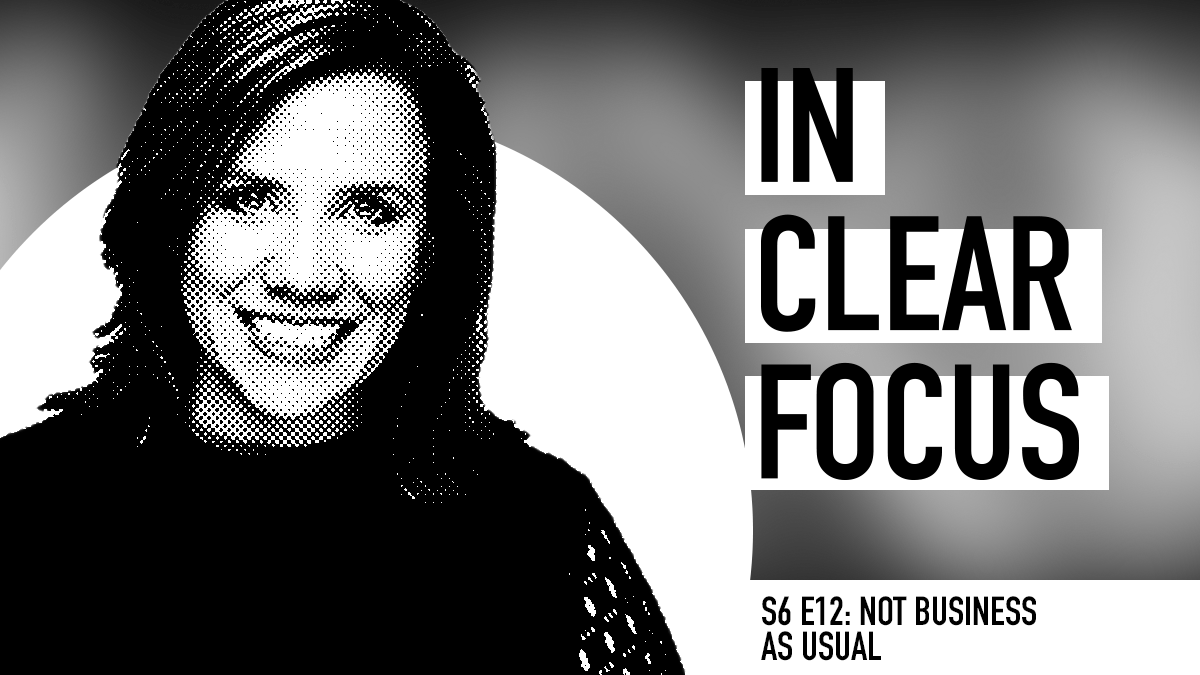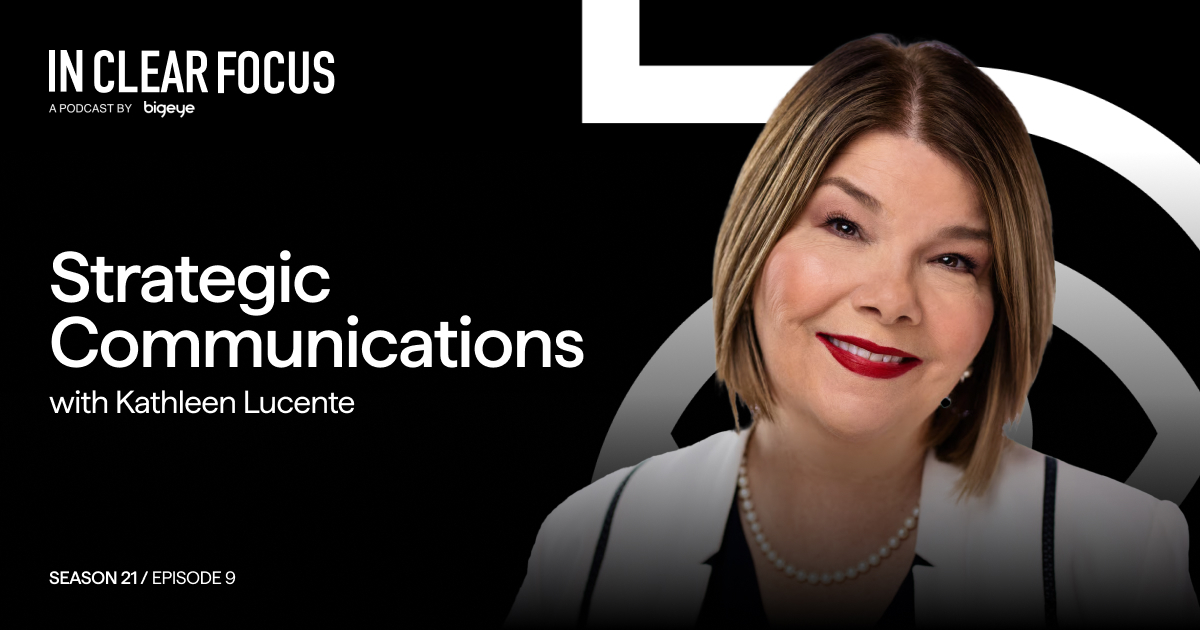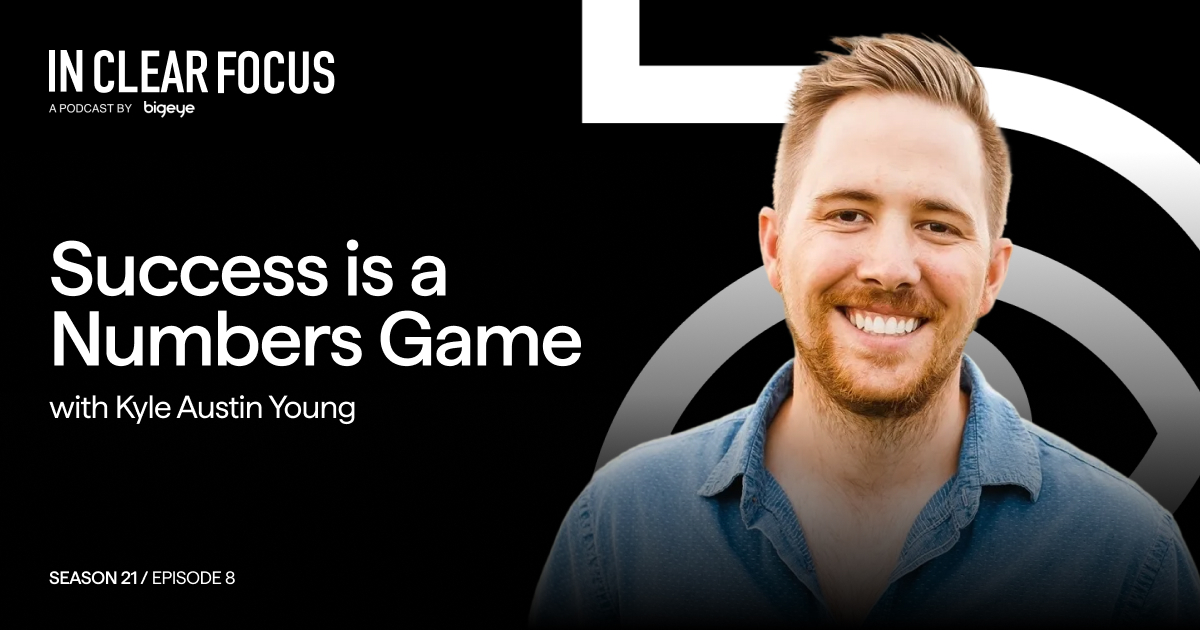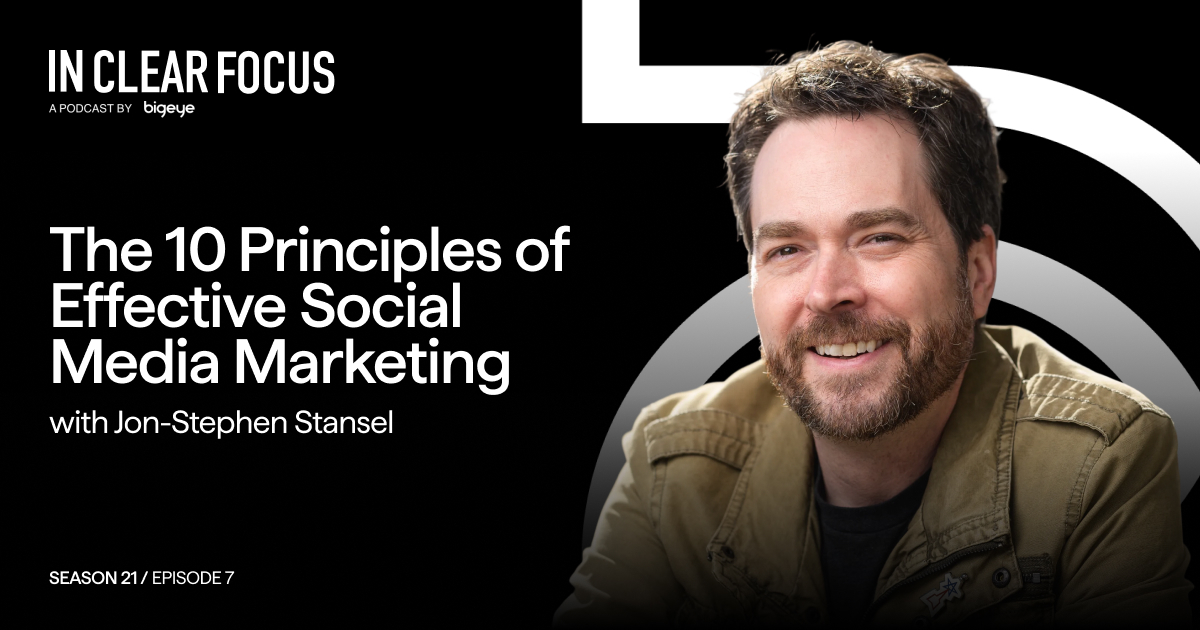Senior Strategist Dana Cassell discusses brand marketing strategies for companies to successfully position themselves for the remainder of 2021 and beyond.
IN CLEAR FOCUS: 2020 has been a year of turmoil, uncovering never-before-seen challenges for marketers. In the last year, companies have had to modify their marketing strategies to keep up with shifting consumer habits. But what does this mean for the remainder of 2021 and beyond? Bigeye’s Senior Strategist Dana Cassell explains how brands should approach their brand marketing strategy with empathy and agility, capitalize on short-term opportunities, and prioritize digital conversion funnels.
Episode Transcript
Adrian Tennant: Coming up in this episode of IN CLEAR FOCUS:
Dana Cassell: The 2021 marketing strategy is about being inclusive in our language and in our images and our efforts in a way that’s authentic to our brand and the products and services we offer.
Adrian Tennant: You’re listening to IN CLEAR FOCUS, fresh perspectives on the business of advertising. Produced weekly by Bigeye. Hello. I’m your host, Adrian Tennant, VP of insights at Bigeye. An audience-focused, creative-driven, full-service advertising agency, we’re based in Orlando, Florida, but serve clients across the United States and beyond. Thank you for joining us. 2020 was a year of unprecedented turmoil. Now with the first quarter of 2021 behind us, it’s clear that marketing and advertising are still far from being back to normal. Behaviors established during the pandemic have changed many customers’ expectations and habits in relation to branded products and services. In 2020, millions of people in the US moved more of their shopping online and reconsidered the priorities and values that drive their brand preferences, purchase behavior, and loyalty. But as we’ve discussed throughout this season of the podcast, the extended impact of COVID-19, while certainly disruptive, has also presented opportunities for marketers to engage with customers in new channels and to develop fresh insights around consumers’ mindsets. To wrap up season six of IN CLEAR FOCUS, we’re going to be hearing from Bigeye’s Senior Strategist, Dana Cassell. Providing direction to brands across a range of engagements. Dana works with client-side marketing leaders, facilitating Bigeye’s vision discovery sessions, and helping our clients establish differentiated brand strategies. Dana recently created a webinar in which she discusses marketing strategy for the remainder of 2021. In today’s podcast, you’re going to hear extracts from the webinar as we unpack these trends and what they could mean for marketers in the longer term. Over to Dana as she explains why 2021 is not business as usual.
Dana Cassell: I’ve identified four key tenets of marketing strategy for the remainder of 2021. Each of the components of the 2021 marketing strategy are at least loosely related to the global pandemic and the way it’s impacted business and people. Today, I’m going to spend some time talking about adding empathy to your value proposition and some examples of companies who are doing this right, why it’s important that everyone in your organization who touches the customer journey can clearly articulate your digital conversion funnel. We’ll break down the buzzword agility to a no-nonsense approach that focuses on capitalizing on small windows of opportunity. And then lastly, we’re going to talk a little bit about you and what personal skills 2021 is going to demand of the CMO. Over the last decade, it’s become increasingly more normal to hear emotionally connective language out of large organizations. Over the next few minutes, while we talk about empathy and the value proposition, I’d encourage you to parse through your own organization. What have you done with empathy and has that been mostly an internal communications effort or external comms? It’s pretty common for us to run across organizations who have embraced empathy with their employees. So who have understood that the value of culture and retention is important from an internal perspective. What we’re going to talk about today though, is how adding empathy to the value proposition impacts the bottom line of the organization from a marketing perspective. And there are certainly examples of this that have been in the marketplace for a while. In healthcare, we hear “patient first” regularly, and in banking, it’s about helping customers achieve personal goals, like buying their first home, or planning for college, or planning for retirement. So 2020 has really forced our hand as marketers to add empathy to the value proposition for our customers. As a strategist, I like to make decisions using data. So I’m curious what the data has said about the importance of empathy with consumers. And there was a recent Nielsen Visual DNA study that surveyed people across multiple nations affected by COVID-19 both before and during lockdown. Respondents were shown a selection of images depicting various degrees of agreeableness and the study found that compared to pre- lockdown, consumers’ perceptions are now leaning toward being more open, trusting, and approaching the world with open arms. So it’s not just our intuition and personal experiences that tell us that empathy is important. It’s data. Customers are now choosing brands and feeling more positively about brands that effectively communicate empathy to their customer base. Let’s talk about the value proposition in features and benefits language. If one of the features of your value proposition is authority, the benefit is that it instills a sense of confidence in the consumer. If a feature of your value proposition is empathy, the benefit is that it tends to move consumers toward action. So the question here is how can your value proposition have both a sense of authority and a tone of empathy? Those who have call centers in their organizations know that the idea of adding empathy is not new. Eighty-four percent of customers say their last customer service interaction via call center did not exceed their expectations. So call centers have been working on adding empathy into their conversations and scripts for quite some time now. Here’s a list of questions and conversation starters that are frequently used in call centers who believe that empathy is key to increasing customer satisfaction. Asking questions like “what’s the best-case scenario for you?” Or even “we appreciate your patience.” And “that would frustrate me too”, are all great examples of how call centers are incorporating empathy to increase satisfaction. So now the mandate is on us as marketers to begin including empathetic language and images and ideas into our marketing, advertising, and public relations efforts. Kind of taking a cue from where our call centers have been working over the last few years. While there are so many wonderful examples of companies being empathetic over the last 13 months or so there are three, in particular, I’d like to share with you today. The first example is Allbirds. On March 20th of 2020, Allbirds announced an effort to US healthcare workers, as a token of their appreciation for frontline workers, they offered a pair of wool runners for free while supplies lasted. They had an incredible response, distributing more than $500,000 of shoes in under a week. More than the effort of donating to the healthcare community, they heard from a ton of customers in support of their effort. Their customer base also asked them to make some changes. Their customers wanted a “buy one, give one” option on their website, as well as an option to donate a pair to a healthcare worker. Both of those options Allbirds quickly implemented on their site. Here’s what I like about this example of corporate empathy. They saw a need. They examined their ability to meet a need and then they executed. And if you go back and look at their Twitter feed from that crazy week, you’ll see that it wasn’t without roadblocks, they had a few technical glitches. The UK was wanting them to roll it out there. So certainly it wasn’t without its own struggles, but they executed it beautifully. They communicated in an authentic way. It was a great fit for their brand and it created meaningful connections within their target market. The next example is a brand campaign with IKEA and the campaign is called “home is a different world.” You can find the extended version of this out on their website, but the concept is that they are understanding the difficult things our world can be right now and that our homes can be a stark contrast to that world.
Female Voiceover: The world is full of rules and regulations. But my home is full of joy and fun. It’s lovely. So lovely. The world waits for no one. But my home always waits for me. The world can get gloomy, but my home is lit. The world gets heated, but my home is chill. The world is loud, but my home is quiet. Well, most of the time. The world is gray, but my home is colorful. The world fights and breaks up. At home, we like the make ups. The world tells us how to be. But my home likes me just as I am, because home is a different world.
Dana Cassell: It’s a beautiful approach to understanding how customers are feeling in the world right now and how their home can counterbalance that. And of course, IKEA is all about helping people build their homes. On the landing page from that campaign, IKEA has the extended cut. And then of course, the collection of products featured in the ad. The reason I bring it up today, it’s not that IKEA gave away half a million dollars in product, but they understand the context where their ad is going to be landing and speak to their customers in a way that makes them feel understood. This is an excellent example of an empathy-driven ad campaign. The last example of corporate empathy I want to chat with you about involves the meditation app, Calm. Of course, the pandemic has led to a surge in downloads of mental wellness and meditation apps, but the numbers are quite staggering. Downloads of mindful and meditation apps doubled in April 2020 over January of 2020. And you know, January is usually a month where healthcare surges anyhow. And Calm itself saw a 31 percent rise in April compared to January. The apps used a variety of approaches to grow business mid pandemic, including offering free access to frontline medical professionals and first responders. Calm did launch a page of free resources and that landing page, which is still up, you can find it easily, is an excellent example of empathy and copywriting. They have some beautiful lines there. But they also began to focus on partnerships to expand free access to more users over a long period of time, while simultaneously growing their business. For example, in May of 2020, Kaiser Permanente announced it was going to make Calm’s apps premium subscription free for its members. It was the first healthcare system to do so. So, whether it’s an actual donation, an empathy-driven campaign, or strategic partnerships that extend your product’s reach while achieving the result of connecting empathetically with customers, I’m curious what you’ll do in 2021 to bind empathy into your value proposition.
[MUSIC]
Okay, moving on to tenet number two: Prioritizing your digital conversion funnel. By now you’re probably sick of hearing in 2020 that we experienced five years of growth in three months’ time for e-commerce. That means there’s so much momentum into online shopping and purchasing that we can no longer ignore optimizing our conversion funnels. I believe that anyone in your organization that touches a part of the customer journey from awareness through advocacy should be able to articulate where their business activities align on your conversion funnel and what the triggers are that they have to pull to increase conversions along the way. Historically talk of the conversion funnel has really stayed within the marketing department, maybe sometimes reaching into meetings in the C-suite, but very rarely has the entire organization fully understood the conversion funnel through the customer journey. But the mandate of 2020 and the growth in e-commerce is that the entire organization now becomes a part of this conversation. There are three trends in the marketplace that have convinced me that digital conversion funnel should be a focus of 2021. And those are “storelessness”, “digital majority”, and “click and collect”. The data shows that in 2020, North America saw a 32 percent increase in retail e-commerce sales that that number in 2021 will still be nearly 15 percent. So it’s clear that the data suggests our conversion funnels need to be prioritized. And “click and collect” I think is fascinating as well. This is where customers order and pay for something online and then choose how to collect it, usually in-store or curbside. 2020 saw an astonishing 60 percent growth in “click and collect” retail sales and the industry is predicting even more growth over the next two years: 10 percent this year and 15 percent in 2022. It’s clear that customer habits with e-commerce have solidified and to me, that means the digital conversion funnel needs to be working well from top to bottom. And your organization needs to know what levers to pull when we need to convert better step-to-step. I’m curious if you could articulate in 60 seconds or less the desired conversion funnel for your business. I think it’s possible that not all of us can, but even if those of us in the marketing department can, could everybody who touches the consumer journey? If not, this is the year to get this figured out. It’s a pretty simple concept – moving folks from awareness to purchase intent, purchase through advocacy. And anyone who touches the customer journey in your organization should be able to clearly articulate how that funnel works and how the work they do impacts moving potential customers from the top to the bottom. It’s a pretty common mistake to want to widen the top of the funnel when we need more customers at the bottom. And it’s always our recommendation that before widening the top of the funnel with a big brand campaign or a big online spend that first we test to make sure that we understand the different steps of the funnel and how they’re working, split test to optimize, and make sure we get those conversion rates as tight as possible from step to step. And once we’ve done that work, then we widen the top of the funnel. I am curiously watching how brands are optimizing their websites and optimizing their digital conversion funnels and look forward to seeing more of the organization understand their role in converting potential customers into sales in 2021.
Adrian Tennant: Let’s take a short break. We’ll be right back after these messages.
Seth Segura: I’m Seth Segura, VP and Creative Director at Bigeye. Every week, IN CLEAR FOCUS addresses topics that impact our work as creative professionals. At Bigeye, we always put audiences first. For every engagement, we commit to really understanding our clients’ prospects and customers. Through our own primary research, we capture valuable data about people’s attitudes, behaviors, and motivations. These insights inform our strategy and guide our creative briefs. Clients see them brought to life in inspiring, imaginative brand-building and persuasive activation campaigns. If you’d like to put Bigeye’s audience-focused creative communications to work for your brand, please contact us. Email info@bigeyeagency.com. Bigeye. Reaching the Right People, in the Right Place, at the Right Time.
Adrian Tennant: How do you identify?
Voices: Female, male, genderfluid, cisgender, genderqueer, nonbinary, transfeminine.
Adrian Tennant: Society is constantly changing and evolving. To understand how Americans feel about gender identity and expression, Bigeye undertook a national study involving over 2000 adult consumers. Over half of those aged 18 to 39 believe that traditional binary labels of male and female are outdated and instead see gender as a spectrum. Our exclusive report, Gender: Beyond The Binary reveals how beliefs across different generations influence the purchase of toys, clothes, and consumer packaged goods. To download the full report, go to bigeye.agency/gender.
Voices: Nonconforming, transgender, two-spirit, transmasculine, genderfluid.
Adrian Tennant: Gender: Beyond The Binary.
Adrian Tennant: Welcome back. Concluding this season of IN CLEAR FOCUS, you’re listening to a special episode with Bigeye’s Senior Strategist, Dana Cassell, discussing why the remainder of 2021 is not business as usual. Before the break, Dana talked about adding empathy to a value proposition and provided examples of brands who are doing this right. Dana also explained why it’s important that everyone in an organization who touches the customer journey can clearly articulate the digital conversion funnel. Next, a look at organizational agility and what the key priorities for marketers should be for the remainder of 2021.
Dana Cassell: 2020 was full of buzzwords, not the least of which was agility. So I bring it up today, not to contribute to the count, but to tell you that I find practical agility to be an extremely important part of the 2021 marketing strategy. This year, I suggest we keep our eyes on long-term planning, but really our focus on short-term execution. As a strategist, I’d never imagined abandoning the long-term vision, but it does seem that companies who have been able to be nimble and successful during the pandemic are able to maintain also a short-term focus. So I’m going to call that agility and that the goal for what we do in 2021. I am curious, what is the actual return on agility? And I wonder at the end of 2021, what will your return on agility story be? Agility looks really different industry to industry. So what it means to be agile and what a small demonstration of agility would be in your industry and with your company is really unique. But it’s clear that the impact of agility is widespread. When your organization is demonstrably agile, you get to show off and rise above your competitors. It’s always impressive when you see an organization, especially right now, mid pandemic, find a way to utilize a short window of opportunity, rather than letting that opportunity pass, waiting too long or getting stuck in red tape. It’s quite impressive. And often those efforts are in PR and have potential viral spread. It’s also impressive with customers. So your current audience will be impressed with your ability to be modern and forward-thinking, responsive to their needs. And indeed, your agility has an opportunity to meet a need. This goes back to those call center questions, like “what is your actual problem?” And “how can we help solve it?” Sometimes the answer is capitalizing on a very short window of opportunity in which your agile response can help to gain market share. So if agility is all about capitalizing on short windows of opportunity, the question is how do we do that? And how do we do that as big organizations who are not necessarily adept at agility? My suggestion is to identify the people within the organization who have an eye for finding windows of opportunity, the people who are natural problem solvers, and who like to optimize and empower them to identify those little windows and bring them to you. And once they’re identified, get a team together quickly to imagine a solution, something manageable that you could design and then test, optimize and deploy quickly. Again, incorporating agility into the 2021 marketing strategy is all about capitalizing on short windows of opportunity so that you can be impressive, gain market share, and potentially earn some PR and viral spread. So identify your little team of agile thinkers and give this a go in 2021.
[MUSIC]
The fourth tenet for the 2021 marketing strategy is about the heart of the 2021 CMO. It’s about you. People who are in leadership positions this year have certainly gotten more than they bargained for. Whether you’re on a board of directors, in a volunteer position, in a classroom, or leading a large organization, leaders are in a position they could never have anticipated. And in 2021, we’re still moving uphill. It’s hard to predict when people will feel like their lives are getting back to normal. We suspect the pandemic won’t end in one huge celebratory moment, but rather a long, subtle, slow shift. There is less predictable about our businesses today than there was 18 months ago. And at this point it’s not necessarily business, it’s personal. At Bigeye, we see honesty, inclusivity, and enduring flexibility as the heart of the 2021 CMO. And this is not just about the way we treat our employees, or what we say in our corporate pillars, and our value statements. It’s about what we actually do. Being honest in the way that we speak, not just telling customers what we want them to think, but telling them the truth and owning up to our mistakes. It’s about being inclusive in our language and in our images and our efforts in a way that’s authentic to our brand and the products and services we offer. And lastly, it’s about maintaining a sense of flexibility that passes understanding. In 2021, we know how much we don’t know. And that means as leaders, we’ll need to stay flexible and encourage and reward our teams for doing the same. At Bigeye, we have a heart for the CMO, and we wish you the best this year, leading your teams.
Adrian Tennant: I hope you enjoyed Dana’s thoughts on marketing strategy for the remainder of 2021. This is the last episode for this season of IN CLEAR FOCUS, but we’ll be back with a new season in a couple of weeks. Here’s some of what you can expect.
Christine Bailey: Deep customer insight needs to inform marketing, from creating the mission statement to creating content, creating segments, customer acquisition, retention, development, social – it really does encompass absolutely every area of marketing.
Sonia Thompson: I moderated the interviews for the black consumers because if it was a white person, doing the interviews, we wouldn’t have gotten the same result. You might not be getting the full value of the research without thinking about how people might be opening up.
Tisse Mallon: the intrusive nature of questions by strangers. Are you a man or a woman? What are you? And then also, even if you respond by saying you’re non-binary People asking me if I have cancer, is that why my head is shaved?
John Gusiff: When you think about experience design, it’s much more than the function of design. It’s a way of thinking as an organization, it’s a process, it’s a series of questions, and it typically takes multi-disciplined capabilities to execute on it. It’s a co-creative process.
Adrian Tennant: That’s a preview of the next season of IN CLEAR FOCUS. Thanks again to my guest this week, Dana Cassell, Senior Strategist at Bigeye, and to all the guests that have made this season our most listened-to yet. You’ll find a transcript with links to the resources we discussed today on the IN CLEAR FOCUS page at Bigeyeagency.com under “Insights.” Just click on the button marked “Podcast.” To make sure that you’re notified when the new season starts, please follow us on Apple Podcasts, Spotify, Google Podcasts, Amazon Music, Audible, YouTube, or wherever you listen to podcasts. Thank you for listening to IN CLEAR FOCUS, produced by Bigeye. I’ve been your host, Adrian Tennant. Until next time, goodbye.




